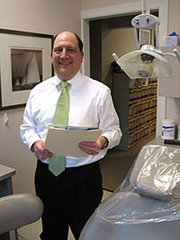Selecting the Best Dentist for a Child
Choosing the right dentist for one’s child is one of the most important decisions that a parent will make. What should a parent consider when choosing a pediatric dentist? The American Academy of Pediatric Dentistry offers a few suggestions:
*Does the dentist have special training or interest in treating children?
*Is the dental office set up for children? For example, does it offer toys, books, games or child-sized furniture?
*How does the dental office manage emergencies?
*Is the office conveniently located to your home or child’s school?
*Does the practice accept your dental benefit plan?
*Is the dentist a member of the American Dental Association and the American Academy of Pediatric Dentistry?
Here’s a pop quiz: How often should a person replace their toothbrush? "Once a year," said Terrie Andrews of McLean.
When should a parent schedule a child’s first dental appointment? "Just after their 6th birthday," said Julie Mahon, an Alexandria mother of 2-year-old twins.
Both answers are incorrect, but consistent with the findings of a new survey by the American Dental Association, which tested the average person’s knowledge of oral health care. On average, Americans did not know the answers to questions ranging from how often to brush to what causes cavities.
THE SURVEY is part of an initiative, launched this summer, aimed at educating the public about maintaining healthy teeth. Dental care experts say prevention, care and treatment information are key to fighting gum disease and keeping teeth healthy. "Good dental health is important, as we are living longer and we need to make the one set of teeth we get last a lifetime," said Dr. Matthew Messina, ADA consumer advisor.
In fact, toothbrushes should be replaced every three months or as soon as the bristles become frayed or worn. The ADA also recommends brushing one’s teeth twice per day and says a child’s first dental visit should take place no later than six months after the first tooth appears.
More than 80 percent of those surveyed believe sugar causes cavities. They’re actually caused by acid that forms when germs in the mouth feed on sugar. The acid attacks and weakens the tooth enamel, allowing a cavity to form.
The survey showed that many believe gums that bleed after brushing is normal, but experts say such bleeding could be a sign of early gum disease. "Periodontal disease is a slowly progressing disease where the early warning signs are subtle. There is seldom any pain until the disease is very advanced. Redness and puffiness in the gums around the teeth are something to watch for. Bleeding of the gums when someone brushes or flosses is not normal and should be evaluated. Eventually, pain and swelling from gum infections will occur, but the damage is advanced by that point," said Messina.
Diet plays a role in healthy teeth, as well. "Don’t underestimate the role of nutrition and the role that food choices play in preventing gum disease and maintaining healthy teeth. The presence of too much or too little of any nutrient can have harmful effects, particularly on the mouth and teeth, and may contribute to oral diseases and infection," said Dr. Raymond K. Martin, spokesman for the Academy of General Dentistry. "Your teeth and jaws are made mostly of calcium. Without enough calcium in your diet, you risk of developing gum disease and tooth decay. Iron deficiency can cause your tongue to become inflamed, and sores can form inside your mouth." Martin added that a lack of vitamin B3 can cause bad breath and canker sores.
Dentistry on the Edge: The Latest Technology in Cosmetic Dentistry
While a toothbrush and floss are considered the keys to a beautiful smile, cosmetic dentists have new tools in the quest for perfect teeth. The American Academy of Cosmetic Dentistry (AACD) says a few technological advancements are increasing safety, efficiency and patient comfort during dental procedures. Topping the list:
*Computer-Aided Dentistry-Computer-Aided Manufacturing: Dental restorations like porcelain crowns can now be made faster and without the mess of traditional, goop-filled rubber molds used to make impressions of one’s teeth. The new procedure uses 3-D scans and computer software to create perfect restorations.
*iPad and Smartphone Applications: Tasks ranging from managing dental records to displaying x-rays are now made easier with a few new iPad and smart phone applications. One such application is the Smile Touch Guide, created by AACD dentist David Traub, DDS. Used for virtually any cosmetic procedure, dentists and patients can work together to decide on the correct shape and length of the teeth. The patient can see what the full set of teeth will look like and make changes.
*Digital X-Rays: With digital x-rays, cosmetic dentists can reduce the amount of radiation patients are exposed to with standard x-rays by as much as 90 percent. The dentist places a small camera into the patient’s mouth and takes a picture. An image appears on a computer screen almost immediately. Cosmetic dentists say digital x-ray pictures are clearer than those taken with standard machines.
*Botox: Cosmetic dentists are now using Botox and dermal filler treatments to treat problems like temporomandibular joint (TMJ) disorders.
